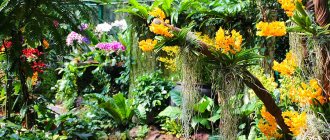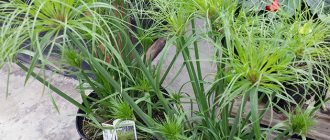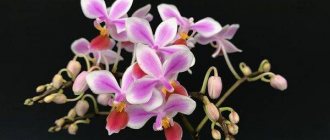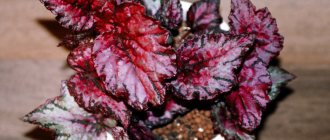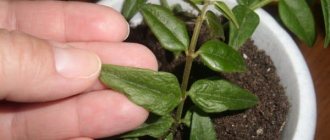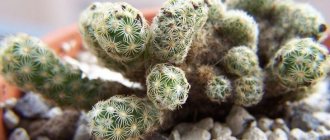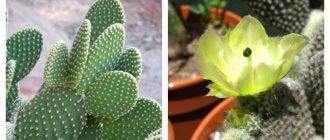Phalaenopsis has taken pride of place on the windowsills of experienced gardeners. And for some, this representative of the Orchid family became the discoverer of a plant collection, winning the heart and soul.
Of the diverse and magnificent varieties, one can note one of the most spectacular exotics - the red orchid. It can become a real decoration in any room or bring joy as a living gift.
In natural conditions, flowers with this color
are rare, but they are not difficult to find among the hybrids on the shelves of flower shops. Caring for plants is simple, but it has its own subtleties and nuances, the implementation of which will allow you to achieve long-term flowering.
Red phalaenopsis orchids
Red flowers are found in different types of orchids. In everyday life, you can most often find phalaenopsis, since compared to other species, they most easily adapt to home conditions.
This genus is represented by more than 70 species of epiphytic plants that are monopodial.
The number of evergreen leaves is approximately 4 to 6, slowly aging, turning yellow and dying. They are then replaced by growing young leaves, reaching a length of up to 50 cm and a width of 5-10 cm.
On window sills, flower growers most often display Phalaenopsis hybrids with a pleasant Ph. amabilis, Phalaenopsis Schiller Ph. schileriana and Phalaenopsis Stewart Ph. stuartia.
Plant collectors, in turn, have a large assortment of species and hybrids.
Advice! The plant is unpretentious. If the conditions are close to natural, then phalaenopsis can delight with its flowering twice a year for 4-5 months. There have been cases when red phalaenopsis delighted with its flowering for as long as 8 months.
Among the orchids with red flowers are the following varieties:
- Vanda is a representative of orchids, not related to phalaenopsis;
- Cattleya is one of the types of orchids with bright flowers (also not phalaenopsis);
- Cymbidium - there are species with red flowers (And this is not phalaenopsis);
- Red Buddha;
- Red Dragon;
- Red Jaguar;
- Harlequin;
- Kimono.
Red Buddha (Buddha's Treasure).
Vanda ampullacea.
Cymbidium Clarisse Austin 'Best Pink'.
Phalaenopsis hybrid Kimono.
Phalaenopsis with red flowers look very luxurious . Up to 40-50 flowers with petals similar to butterfly wings can bloom simultaneously on a flexible stem. This wonderful living plant will become an unusual and bright accent in your home and give it a sweet aroma.
Popular varieties of red and burgundy color: description and photo
Leko Fantastic
Leco Fantastic. A rare and capricious hybrid. Produces two branching peduncles. Each one produces 10 buds. The flowers are 8–9 cm in diameter. The color of the petals is peach, with orange and pink undertones. The center is yellow, turning white towards the very center. There is a speckled crimson pattern on the lower and side petals. The lip is orange-pink, mustachioed, and strongly curved upward.
The unusual color of this orchid is classified as red phalaenopsis due to the specks on the petals. But its colors include pink, brick and even golden tones.
Montreux
Montreux. Sometimes the name Montrex or Montru is found. Phalaenopsis with wine-burgundy flowers, 8–9 cm in diameter. The petals are monochromatic, with a glossy surface. Peduncles about 60 cm.
Salus Fragrance
Salu's Fragrance. A fragrant miniature hybrid with a light herbaceous scent. Peduncles about 25 cm. Flowers up to 7 cm in size with shiny, waxy petals. Spectacular dark burgundy color with a plain lip. Leaves are greenish-burgundy.
Elegant Deborah
Elegant Debora. Produces 2–3 peduncles with an average height of about 55 cm. The color is closer to burgundy, with a crimson tint, not monochromatic, with a white or pinkish edge along the edge of the petals. Lip with a yellow spot. Flowers up to 8 cm in diameter.
Horizon
The hybrid has two branched peduncles up to 65 cm high. Flowers are 7–7.5 cm in diameter. The petals have a waxy texture. The color is closer to brick with a brownish-red tint. The lip is white with a yellow border.
Kimono or Burgundy
Floriclone Kimono, can be found in stores under the name Burgundy. Flowers with a rich, velvety burgundy color. The pattern on the petals resembles a fine mesh. This variety is very prolific; about 200 pieces can bloom on one peduncle. Standard size buds are up to 7–9 cm.
Brazil
Brazil. Phalaenopsis multiflora. The orchid is no higher than 25 cm. The flowers are about 3–4 cm in diameter. The petals are painted in a burgundy-beetroot shade with noticeable darkish veins. The center is light pink. The lip is teardrop-shaped with a yellowish base.
The variety has a pleasant fruity aroma.
Ola. A hybrid with a light smoky floral aroma. The flower stalks are branched, up to 70 cm. The diameter of the flowers is 8–8.5 cm. The petals are dense with a velvety surface. The color is light burgundy with a red undertone. There is a narrow yellow border along the edge. There is a yellow spot at the base of the trapezoidal lip.
External characteristics and distinctive features
Red phalaenopsis are the most striking representatives of the Orchid family. On window sills you can find several varieties with red flowers:
- Red Buddha belongs to novelty-phalaenopsis. These plants are distinguished by an almost unlimited period of life of peduncles, which grow from the upper vegetative bud after dormant periods. Peduncle few-flowered. But there can be several dozen flower stalks themselves, which ensures lush flowering;
Red Phalaenopsis Buddha's Treasure. - Red Dragon – hybrid of spotted phalaenopsis, belongs to mini varieties;
Phalaenopsis Dragon Tree Eagle 'Red'. - Red Jaguar is a giant phalaenopsis hybrid. This is a large, unusually beautiful plant. It is difficult and capricious to care for, which is why it is not so often found in flower growers’ collections.
Red Jaguar.
Peculiarities
Scarlet orchids at home are better known as phalaenopsis. This exotic plant easily adapts to home conditions. The luxurious plant is monopodial. It has a neat elongated stem, strong leaves, bright green in color. The leaves will retain their brightness and green color for a long time, then turn yellow and die.
The number of inflorescences varies due to maintenance conditions. With proper care, an orchid can produce up to 40 inflorescences in one flowering season.
The flowers have a delicate, pleasant aroma and over time can change shade from bright scarlet to dark red, and the petals themselves resemble butterfly wings.
Let's look at the most popular varieties.
Red peacock
This is the most famous and unique species. The flower is very delicate and thin. Its yellow-red buds are very reminiscent of peacock feathers, which is why the flower got its name.
Red Buddha
It belongs to the novelty phalaenopsis. The flowers are not particularly large in size, but since there can be several dozen of them, they form a lush inflorescence.
Red Dragon
It is a cross between the pinto phalaenopsis. Its inflorescences are small, which gives the flower a special extravagance.
Red Jaguar
This is a monohybrid of the giant phalaenopsis, has large large buds. This amazing, beautiful plant is characterized by capriciousness in care, for this reason it is rarely included in collections.
Regions of distribution in nature
Epiphytic orchids with bright red flowers are widely represented in the plant's homeland in the tropics of South Asia, where there are frequent rainfalls. Such forests are found in Indonesia, the Philippines, New Guinea, the north and east of Australia, and the islands of the Malay Archipelago.
Orchids are considered to be exotic plants that can only grow in the tropics. But in the wild, representatives of the family can be found on almost all continents except Antarctica.
Amazingly, even in the countries of the former Soviet Union you can see 49 representatives of these oldest inhabitants of the flora.
The largest number of varieties of graceful butterfly-like flowers still grow in the humid tropics. It is there that they have the best conditions for development and flowering: suitable air exchange, necessary humidity and protection from the burning sun.
In this area, epiphytic plants that grow upward are found in greater numbers. Temperate climates boast terrestrial varieties of the plant with tuber-shaped rhizomes. There are not very many such plants - about 75.
Orchids are so adaptable to any natural conditions that they are not found only in very cold or dry regions.
Cattleya - Queen of Orchids
Cattleya is often called the queen among all other orchids. She earned this title not only for her beauty, but also for her “capriciousness” and demanding care. The reward for a painstaking gardener will be beautiful flowers and a sweet aroma.
The homeland of the plant is Brazil. At the moment, about 40 Cattleya hybrids are known, and in natural conditions - about 65.
Cattleya is one of the sympodial species of the Orchid family. Such plants grow in width, as young shoots appear next to old ones. The stem grows from pseudobulbs that appeared earlier and accumulate moisture and vitamins.
Among Cattleyas there are epiphytes that grow on trees, and lithophytes that grow in gorges and rock breaks in open areas under direct sun.
Photo of red Cattleya orchid.
Important! You can distinguish the capricious queen from other species of the Orchid family by the shape of the lip - a petal that contrasts with the color of others in the flower.
The color of the flowers is represented by all known shades. Among the most famous varieties of cattleyas:
- Triana;
- two-color;
- Bowring;
- Forbesa;
- Giant.
On the peduncle of the plant there can be approximately 10 flowers with a diameter of 5 to 25 cm. There are also single inflorescences. Flowering duration is about a month. In autumn and winter, the plant rests.
The height of an adult plant can be about a meter or even higher, starting from just a few centimeters.
Care
Of all the types of orchids, phalaenopsis are the most suitable for growing at home. This is a non-capricious variety that, compared to others, requires compliance with minimal conditions.
For successful flowering and growth, phalaenopsis needs:
- Correct lighting;
- Maintaining temperature conditions and maintaining high humidity levels;
- Watering and fertilizing;
- Timely transplant.
Phalaenopsis are light-loving plants that must be protected from direct sun. The most suitable place would be by the east window or on the windowsill.
Phalaenopsis are light-loving plants.
Red phalaenopsis prefers high air humidity and a daytime temperature of approximately 22-27 degrees plus, at night - no lower than +18 degrees Celsius. If you want to achieve flowering, the difference between night and day temperatures should be at least 5 degrees.
Proper watering is one of the main components in plant care. If you make mistakes, the plant may die. During the absence of flowers, phalaenopsis is watered no more than once every 7-10 days. In hot weather, watering is required more often: approximately every 2-4 days.
You can determine the need for watering by looking at the top layer of bark; when it dries out, it needs to be watered. When watering and spraying the plant, it is important not to allow water to get into the axils of the rosettes of the leaves , as this can cause rotting. If moisture gets in, it can be removed with a cotton swab. You cannot water the plant with cold water.
Feeding phalaenopsis is necessary during the period of active growth. Fertilizing is carried out with a solution of complex mineral fertilizers specifically for orchids approximately once every 20-25 days. There is no need to feed the plant during rest.
The growth period of phalaenopsis does not always coincide with the spring-summer period. Flowering can also occur in winter. The resting period of the plant is not as pronounced as, for example, Cattleya.
The dormant period begins at the end of flowering and is determined by the general condition of the plant. At this time, the preferred temperature is 16 degrees Celsius.
be replanted approximately once every 2 years after flowering. But if the plant grows quickly, you can carry out the procedure more often.
Advice! After a dormant period, the plant needs a difference in day and night temperatures for 2-4 weeks to stimulate flowering. Once the buds appear, there should be no temperature changes, otherwise they may fall off.
The peduncle remaining after flowering may remain green and subsequently buds will appear on it again. It can also produce babies for plant propagation. If the peduncle dries out, it should be cut off at a distance of 1-2 cm from the beginning of growth. Sometimes only the top bud on the peduncle may turn yellow or dry out: it should be cut off.
When buying a plant in a flower shop, you need to carefully examine it:
- evaluate the appearance of the plant;
- condition of the rosette - there should be no rotting of the leaves at the base, otherwise the plant will die;
- there should be more unopened buds on the peduncles;
- Evaluate the condition of the roots if possible.
After purchase, the plant may need replanting:
- if the phalaenopsis cannot stand on its own and turns over,
- there is little substrate in the flowerpot and the flower dangles,
- more than half of the roots are damaged.
Transplantation scheme.
If the plant feels good, then it is not advisable to touch it before flowering.
To prevent the occurrence of diseases and pests, the above care requirements should be observed.
How to care?
Caring for a red orchid is not difficult, since it is an unpretentious plant and is no different from caring for other varieties of orchids. There are some points that, if observed, will help prolong the time of beautiful flowering. This can be done by adhering to the following simple rules:
- create the correct temperature regime;
- maintain optimal humidity levels;
- maintain uniform watering and fertilizing;
- provide sufficiently intense lighting;
- timely fertilization of plants;
- transplantation if necessary;
- Constant monitoring of the health of the orchid is mandatory.
Particular attention should be paid to the roots. They should be emerald green. If they change color, then this is most likely a fungal-viral disease or the root system is damaged, which can lead to the death of the flower.
Lighting
This flower is a light-loving plant. Bright lighting is the norm for orchids. But you need to be careful of direct sunlight, as this can lead to burns of the leaves. The light directly determines how the leaves change shape and color.
The length of the correct daylight hours for orchids is 15 hours, so it is recommended to leave the flower pot on the windowsill. In this case, the leaves acquire a bright emerald hue.
Humidity
The orchid loves humidity, so in warm weather it needs to be sprayed with warm water. It is also recommended to do this in winter, since the air at this time of year is cold and dry. However, during the flowering period the orchid should not be sprayed.
The optimal time for spraying is morning and evening.
Watering
The shallow root system is the main difference of this plant. In order to water the flower, it is recommended to use soft rainwater to transfer through the water the nutrients necessary for the root system.
If it is not possible to get rainwater, then it is better to use regular boiled water.
Another way to water a plant is to lower the flower pot into a container filled with water for 20 minutes. Then place on a tray to remove excess liquid. It is recommended to water the plant once every 7 days.
Fertilizer and nutrition
It is especially recommended to add vitamins during periods of vigorous growth. It is not recommended to fertilize an orchid immediately after purchase, since it must first adapt to new conditions. And to feed the plant, it is better to use aqueous solutions rather than tablets.
You need to buy these vitamins in specialized stores so as not to buy a fake and thereby not harm the plant. Experts advise applying fertilizer every 20 days.
Transfer
A transplant is necessary in cases where:
- the flower does not hold tightly in the pot and falls;
- root tips appeared on the surface;
- the lower leaves began to fall off;
- the roots are damaged and rotting.
It is optimal to replant orchids every two years, but always after flowering has completed . If necessary, transplantation is done more often. When transplanting, the new container should be larger in size each time than the previous one. The substrate must include peat, charcoal and pebbles.
The most optimal method of transplantation is the so-called plant transshipment.
The essence of this method is as follows. First, thoroughly moisten the soil to free the roots. Next, carefully remove the flower from the pot and place it in a new container, after which moderate watering is recommended.
Pests and diseases
The red orchid can be susceptible to diseases and pest attacks. One of the unwanted guests is the thin tick. Plaque and small black dots are signs of the life activity of this pest. There are several ways to combat ticks. The surest and simplest is to increase the humidity.
There are also fungal infections in the form of growths and spots. All this leads to loss of leaves and discoloration. To cure an orchid, you will have to replant it.
The most dangerous parasites are aphids and whiteflies. In this case, in order to prevent the death of the plant, it is necessary to destroy the insect eggs.
The red orchid has bright, interesting shades, so it is often used as home and garden decor, and it is also quite unpretentious. In order for the plant to grow and develop well, you need to clearly and correctly follow all the recommendations from experienced gardeners. Then the long flowering and high life expectancy of the luxurious red orchid can be guaranteed.
See below for information on proper orchid care.
